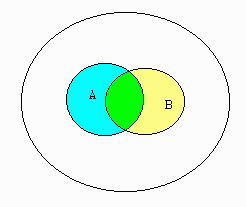Probability
For an experiment we define an event to be any collection of possible outcomes.
A simple event is an event that consists of exactly one outcome.
or: means the union i.e. either can occur
and: means intersection i.e. both must occur
Two events are mutually exclusive if they cannot occur simultaneously.
For a Venn diagram, we can tell that two events are mutually exclusive if their regions do not intersect
We define Probability of an event E to be to be
|
number of
simple events within E |
We have the following:
- P(E) is always between 0 and
1.
- The sum of the probabilities of all simple events must be
1.
- P(E) + P(not E) = 1
- If E and
F are mutually exclusive then
P(E or F) = P(E) + P(F)
The Difference Between And and Or
If E and F are events then we use the terminology
E and F
to mean all outcomes that belong to both E and F
We use the terminology
E Or F
to mean all outcomes that belong to either E or F.
Example
Below is an example of two sets, A and B, graphed in a Venn diagram.

The green area represents A and B while all areas with color represent A or B
Example
Our Women's Volleyball team is recruiting for new members. Suppose that a person inquires about the team.
Let E be the event that the person is female
Let F be the event that the person is a student
then E And F represents the qualifications for being a member of the team. Note that E Or F is not enough.
We define
|
Definition of Conditional Probability
|
We read the left hand side as
"The probability of event E given event F"
We call two events independent if
|
For Independent Events P(E|F) = P(E) |
Equivalently, we can say that E and F are independent if
|
For Independent Events P(E and F) = P(E)P(F) |
Example
Consider rolling two dice. Let
E be the event that the first die is a 3.
F be the event that the sum of the dice is an 8.
Then E and F means that we rolled a three and then we rolled a 5
This probability is 1/36 since there are 36 possible pairs and only one of them is (3,5)
We have
P(E) = 1/6
And note that (2,6),(3,5),(4,4),(5,3), and (6,2) give F
Hence
P(F) = 5/36
We have
P(E) P(F) = (1/6) (5/36)
which is not 1/36.
We can conclude that E and F are not independent.
Exercise
Test the following two events for independence:
E the event that the first die is a 1.
F the event that the sum is a 7.
Hold your mouse over the yellow rectangle for the answer.
![]()
A Counting Rule
For two events, E and F, we always have
P(E or F) = P(E) + P(F) - P(E and F)
Example
Find the probability of selecting either a heart or a face card from a 52 card deck.
Solution
We let
E = the event that a heart is selected
F = the event that a face card is selected
then
P(E) = 1/4 and P(F) = 3/13 (Jack, Queen, or King out of 13 choices)
P(E and F) = 3/52
The formula gives
P(E or F) = 1/4 + 3/13 - 3/52 = 22/52 = 42%
Back to the Probability Home Page
Back to the Elementary Statistics (Math 201) Home Page
Back to the Math Department Home Page
e-mail Questions and Suggestions